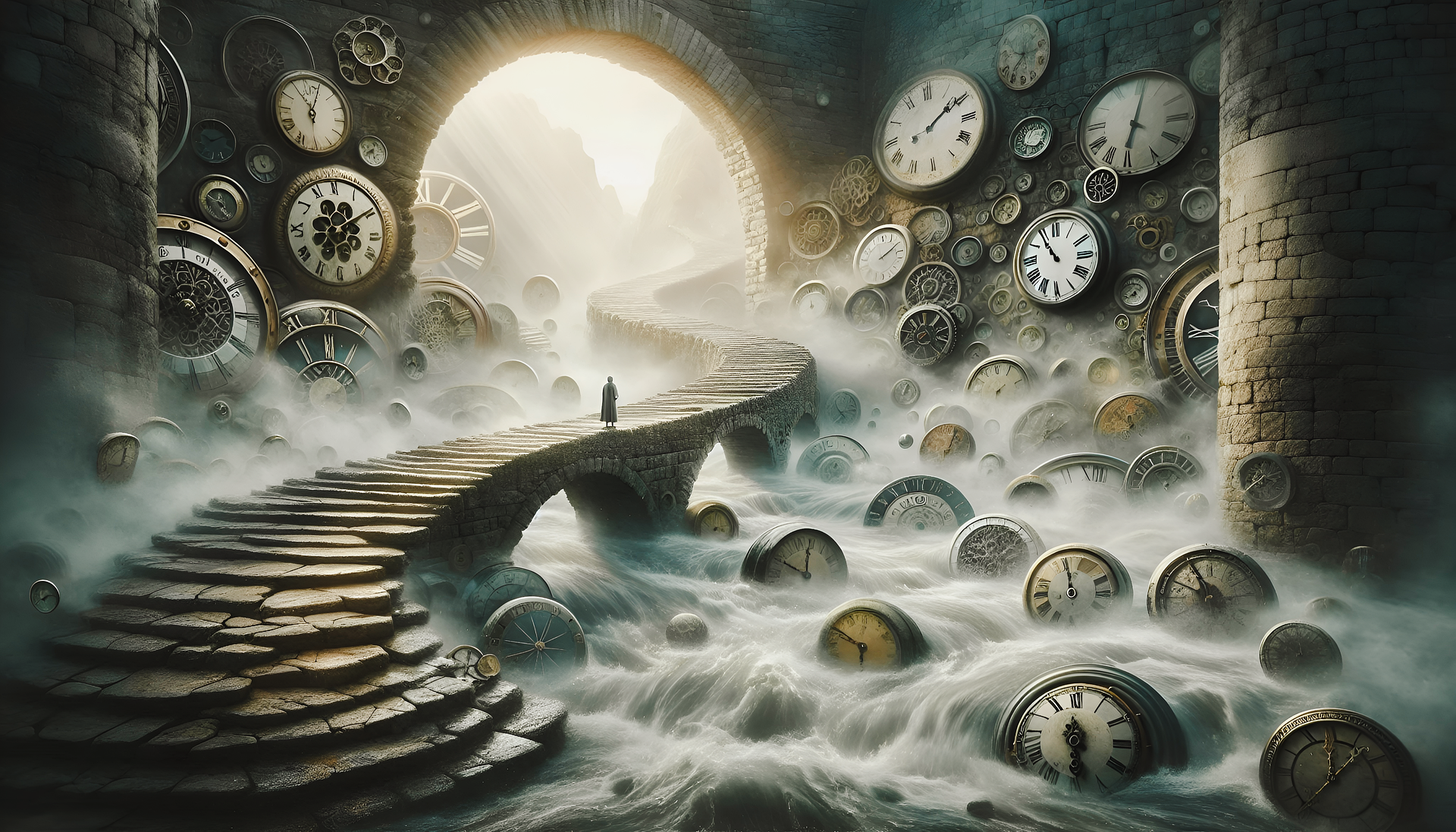⏳ Time
A Foundational Page of Similarity Theory
Similarity Theory proposes that Consciousness, Time, and Dimension form the structural pillars of reality.
This page explores Time as the unfolding framework through which consciousness experiences existence — the sequence of frames that transforms potential into becoming.
See the Introduction to Similarity Theory for the core concepts and structure.
🌀 Philosophical Reflection
🔹 The Nature of Time
In Similarity Theory, time is not only woven into space — it is also interwoven with consciousness. Without awareness to illuminate the frames, time is not experienced at all. Consciousness is what turns the potential of time into the lived reality of becoming.
🪞 Echoes of the Self
As we live and make choices, each decision leaves behind a version of ourselves — not merely as memory, but as an ongoing existence within that moment.
This resembles the Many-Worlds idea: all possibilities branching from events. Yet in Similarity Theory, these branches are not infinite abstractions. They are structured but open — a sink flushing water toward a drain. The overall flow is guided, but the droplets diverge in countless ways.
So it is with time. The structure exists, but freedom lives in the details.
📽️ Frames of Time
Every moment is a frame, a still imprint that exists whether we pass through it or not. These frames resemble a reel of film: static, eternal, yet capable of becoming motion when illuminated by consciousness.
But unlike a finished reel, new frames can be added. Consciousness is not only the viewer but also the contributor — expanding the sequence through every act of choice.
🌌 Predetermination and Freedom
Time is a dance between structure and divergence.
Predetermination: Laws and patterns guide existence — stars burn out, entropy rises, rivers run downhill.
Freedom: Within those boundaries, consciousness bends and sometimes breaks the rules. Droplets splash sideways, cells diverge from their host system, new paths unfold.
The paradox is essential: the universe is neither rigidly mechanical nor infinitely free. It is structured freedom, where becoming is guided by patterns but animated by consciousness — alive through the lens of similarity.
👁️ Time as a Landscape
For beings of higher dimensions, time may appear as a landscape rather than a sequence. What we live as past, present, and future might be visible to them all at once — grooves etched across a wider surface.
As a plant cannot comprehend our world of books and language, we cannot grasp theirs. Yet their perception does not erase ours; it reframes it.
🌀 Beyond the Eleventh Dimension
M-theory proposes 11 dimensions, with time as just one strand. Similarity Theory suggests that beyond mathematics lie realities where new kinds of time may exist: recursive, layered, or multi-directional.
Our models are perspectives — partial but valuable. Just as a whirlpool looks smooth from above but chaotic in detail, higher dimensions may reveal structures of time we cannot yet conceive.
📌 Structured Freedom
Most multiverse models suggest all possibilities already exist. Similarity Theory reframes this:
Structure sets boundaries.
Consciousness introduces freedom within those boundaries.
Reality is not a fixed archive nor a limitless blank canvas. It is participatory — patterned, but open.
🔥 Time as a Doorway
Time is not just the ticking of a clock. It is the first doorway in an infinite corridor of dimensions, each one stranger and more profound than the last.
Entropy provides the arrow; consciousness provides the path. Together, they weave a cosmos where no two journeys are the same.
🔬 Scientific Grounding
Relativity and Elastic Time
Einstein’s general relativity (1915) revealed that time is not absolute but relative to gravity and motion. Clocks run slower near massive bodies or at high velocities — proving time is elastic, inseparable from space.
Quantum Interpretations of Time
The Many-Worlds Interpretation (Everett, 1957) suggests all outcomes unfold in parallel universes. Tegmark (2003) framed this as Level III of the multiverse. Similarity Theory resonates with the branching, but reframes it as structured freedom rather than total predetermination.
Discrete Frames of Time
Loop quantum gravity suggests time may be granular, composed of indivisible “quanta” at the Planck scale (~5.39 × 10⁻⁴⁴ s). Barbour (1999) argues that all possible configurations of the universe exist timelessly, and the flow of time is consciousness moving across them. Similarity Theory aligns in part: frames exist — but new frames can be added through choice.
Chaos, Sensitivity, and Divergence
Chaos theory shows how tiny differences in initial conditions lead to vastly different outcomes. This mirrors Similarity Theory’s claim: structure exists, but consciousness can amplify divergence, shaping new paths within law.
Time as Landscape
Cosmologists like Rudy Rucker (1984) and Brian Greene (2004) describe time as a landscape in higher dimensions. All of time — past, present, and future — may be laid out like terrain. Similarity Theory integrates this but emphasises that perception depends on dimensional consciousness.
Beyond Current Models
M-theory (Witten, 1995) proposes 11 dimensions, but Similarity Theory holds that mathematics is not the final word. Higher realities may contain new forms of time we cannot yet model, just as earlier physics could not yet conceive relativity or quantum theory.
📚 References
Barbour, J. (1999). The end of time: The next revolution in physics. Oxford University Press.
Einstein, A. (1915). The field equations of gravitation. Sitzungsberichte der Königlich Preußischen Akademie der Wissenschaften, 844–847.
Everett, H. (1957). “Relative state” formulation of quantum mechanics. Reviews of Modern Physics, 29(3), 454–462.
Greene, B. (2004). The fabric of the cosmos: Space, time, and the texture of reality. Alfred A. Knopf.
Rucker, R. (1984). The fourth dimension: Toward a geometry of higher reality. Houghton Mifflin.
Rovelli, C. (2004). Quantum gravity. Cambridge University Press.
Tegmark, M. (2003). Parallel universes. Scientific American, 288(5), 40–51.
Witten, E. (1995). String theory dynamics in various dimensions. Nuclear Physics B, 443(1–2), 85–126.
Raphael, S. (2025). Similarity Theory. Wollongong: Author.
🔎 Similarity Theory Summary
A pluralist cosmology where countless individual consciousnesses can merge into collectives and later separate with identity intact.
It rejects monism (no single ultimate mind) and dualism (no permanent mind–matter divide).
Unity is temporary; individuality is eternal.
Read more → Not Panpsychism


